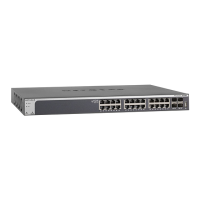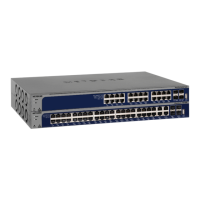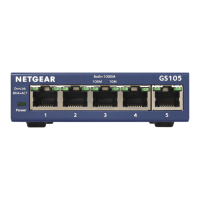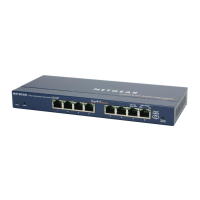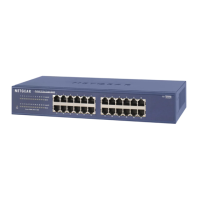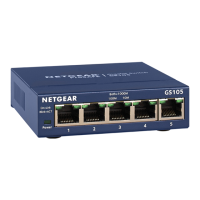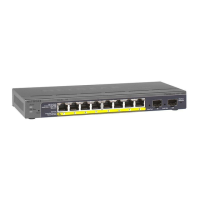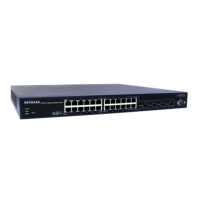Quality of Service
105
XS728T ProSAFE 28-Port 10-Gigabit L2+ Smart Switch
DSCP to Queue Mapping
Use the DSCP to Queue Mapping screen to specify which internal traffic class to map to the
corresponding DSCP value.
Do this for each of the following groups, as required:
• Class Selector (CS) Per-hop Behavior (PHB)
• Assured Forwarding (AF) PHB
• Expedited Forwarding (EF) PHB
• Other DSCP Values (Local/Experimental Use)
To map DSCP values to queues:
1. Select QoS > CoS > Advanced > DSCP to Queue Mapping.
2. For each DSCP value (in each type of differentiated service), select a hardware queue to
associate with the value.
The traffic class is the hardware queue for a port. Higher traffic class values indicate a
higher queue position. Before traffic in a lower queue is sent, it must wait for traffic in
higher queues to be sent. The valid range is 0–7.
3. Click Apply to apply the changes to the system.
Differentiated Services
The QoS feature provides Differentiated Services (DiffServ) support that enables traffic to be
classified into streams and given certain QoS treatment in accordance with defined per-hop
behaviors. For more information, see
DiffServ Traffic Classes on page 204.
Standard IP-based networks are designed to provide “best effort” data delivery service. Best
effort service implies that the network delivers the data in a timely fashion, although there is
no guarantee that it will. During times of congestion, packets might be delayed, sent
sporadically, or dropped. For typical Internet applications, such as email and file transfer, a
slight degradation in service is acceptable and in many cases unnoticeable. Conversely, any
degradation of service has undesirable effects on applications with strict timing requirements,
such as voice or multimedia.
To use DiffServ for QoS, you must first define the following categories and their criteria:
1. Class. Create classes and define class criteria.
2. Policy. Create policies, associate classes with policies, and define policy statements.
3. Service. Add a policy to an inbound interface.
Packets are classified and processed based on defined criteria. A class defines the
classification criteria. A policy’s attributes define the processing. Policy attributes might be
defined on a per-class instance basis, and it is these attributes that are applied when a match
occurs. A policy can contain multiples classes. When the policy is active, the actions taken
depend on which class matches the packet.
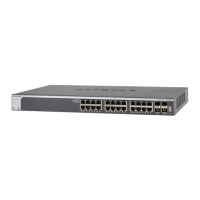
